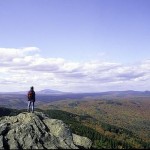
Photographer: George Wuethner
How will the next election impact the idea of large landscape conservation? This topic is not the stuff of campaign speeches or sadly even photo ops. No one spoke at the conventions in Cleveland or Philadelphia about how large landscapes made a difference in their life. However, landscape scale practitioners are interested in how the next election might change the landscape. And one place to look for clues is in the platform of each party. Both the Democrats and the Republican have adopted platforms that offer the voting public some ideas about the party’s principles or goals. Not surprisingly, they offer very different perspectives on landscape conservation
There is no question that the landscape scale approach has prospered under the current administration. Under the leadership of Secretary Ken Salazar (2009-2013) followed by Secretary Sally Jewell (2013 to present), the US Department of the Interior made landscape conservation an organizing principle for much of the agency’s work. For example, the department launched the Landscape Conservation Cooperatives to serve as a centerpiece of these efforts Other department’s including the Department of Agriculture, the Department of the Defense, and others all adopted a big picture strategy. See the recent National Academy Report for a snapshot shot of these program.
So let’s take a look. The greatest divergence between the two parties is the protection of public lands. The Republicans state that “experience has shown… that private ownership is the best guarantee of conscientious stewardship.” The Democratic platform lead with the statement that “…we need policies and investments that will keep America’s public lands public.” In analyzing these two positions, it should be noted that the interpretation in some media outlets that the Republican platform endorses the sale or transfer of our National Parks is an overstatement. However, it is a fair to read their platform as saying that other public lands might receive a lot less protection. This an important distinction as many landscape scale efforts feature a concentration of different kinds of public lands to pull the whole initiative together: Think of Waterton Peace Park in the center of Crown of the Continent or Everglades National Park in South Florida. In both these cases and many more, the public lands of the US Forest Service lands or the US Fish and Wild Refuges are important to reaching critical conservation mass in these landscapes.
A related issue is how America’s public lands will be managed and who should be in the conservation driver’s seat. The Democratic party goals are generally about conservation and protection of all public lands and waters and the document even proposes a funding program to expand state, federal and local parks. The Republican platform takes another tack. It states that “…(we) must balance economic development and private property rights in the short run with conservation goals over the long run”. And speaking specifically of the west, suggests that more public land could be made available to ranching, mining and forestry. The underlying principle being that these lands are best managed by the people who are closest to them.
Another difference is that the Democratic platform explicitly identifies cultural resources as a value to be protected along with natural landscapes as a way to help tell the story of America’s complex and diverse history. This topic is not addressed in the Republican document.
One more indicator of how landscape conservation might fare in the future is in the two parties’ transition teams. The Republicans’ have selected Governor Chris Christie. He has recently run into flak from conservation voters for vetoing open space funding in his home state of New Jersey. While the Democratic team will be headed by no other than the former Obama administration Secretary of Interior Ken Salazar coupled with a platform thatincludes a number of his favored initiatives “…Everglades, Great Lakes, the Arctic, and all that makes America’s great outdoors priceless.”
In conclusion the beauty of large landscape work is that it draws strength from a mix of public and private partnerships. This model of dispersed leadership and support makes it more resilient approach that can probably survive whatever political headwinds are encountered. However, taking the two platforms at their word one direction could be smoother sailing than the other.



2 Responses
Thank you for a remarkably balanced approach to this important but overlooked issue. Those aspects of the Republican platform which you reference resemble the arguments made by mining and timber interests 100 years ago – and their adoption would be a very unhappy centenary birthday present to the NPS. Where have you gone, Teddy Roosevelt?
Thank you for your comment. While party platforms are sometimes dismissed as non-binding political exercises, we need to take parties or people at their word. And history tells us that some of the words in the Republican political platform are pretty ominous for the future conservation of both cultural and natural resources.